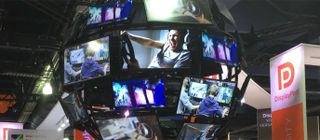VESA DisplayPort 2.1 Tightens Alignment With USB Type-C and USB4
Touts improved coexistence of data and video signals over USB4 connections.

VESA this week released version 2.1 of the DisplayPort specification. The update brings several important changes concerning efficiency, but as you will read, VESA strove to keep things smooth for both implementers and consumers.
DisplayPort 2.1 is more than just backward compatible with DisplayPort 2.0. Due to the efforts of VESA and its partners, "all previously certified DisplayPort 2.0 products… have already been certified to the stricter DisplayPort 2.1 spec." So yes, any GPU, Docking Station, monitor, cable (or anything) certified for DisplayPort 2.0 will fall under the stricter newer v2.1 specification.
VESA says one of the most important things it has tried to achieve with this update is to offer a robust experience. This philosophy applies to users connecting peripherals via a native DisplayPort cable, via DisplayPort Alt Mode (DisplayPort over the USB Type-C connector), or tunneling through the USB4 link. Whichever solution you might use, the alignment of the spec and PHY (physical layer) has been tightened for dependability.
So, if all these things remain the same, and DisplayPort 2.0 and 2.1 are interchangeable, you might be wondering what's the point of the new specification. Perhaps the most important introduction is the new DisplayPort bandwidth management feature "to enable DisplayPort tunneling to coexist with other I/O data traffic more efficiently over the USB4 link." According to the VESA press release, this efficiency comes on top of new mandated support for VESA's visually lossless Display Stream Compression (DSC) codec and VESA's Panel Replay capability. VESA's DSC implementation will reduce bandwidth usage by as much as 67% without visual artifacts. Moreover, the new Panel Replay capability can reduce tunneling packet transport bandwidth by over 99% in certain situations.
VESA Board Chair and VESA DisplayPort Task Group Chair Alan Kobayashi boldly claimed that the higher bitrates supported by DisplayPort 2.1 "offers ample bandwidth for the needs of virtually every practical application."

The announcement also revealed that cable specs were updated. With DisplayPort 2.1, VESA aims to allow for improved capabilities and longer cable lengths, sometimes extending over two meters. "VESA certified DP40 cables support up to the UHBR10 link rate (10 Gbps), with four lanes, providing a maximum throughput of 40 Gbps," VESA explains. "VESA certified DP80 cables support up to the UHBR20 link rate (20 Gbps), with four lanes, providing a maximum throughput of 80 Gbps."
Interestingly, ex-HardOCP Editor-in-Chief Kyle Bennett tweeted last week that multiple sources had indicated to him that AMD Radeon Navi 31 GPUs would offer support for the DisplayPort 2.1 specification. This summer, there were rumors of RDNA 3 supporting DisplayPort 2.0 and UHBR20. Intel Arc LE model GPUs also support DisplayPort 2.0. Considering what VESA has said, both the AMD and Intel GPUs will support DisplayPort 2.1. Putting these into competitive perspective, the recently launched Nvidia Ada Lovelace flagship, the GeForce RTX 4090, supports DisplayPort 1.4.
Stay On the Cutting Edge: Get the Tom's Hardware Newsletter
Join the experts who read Tom's Hardware for the inside track on enthusiast PC tech news — and have for over 25 years. We'll send breaking news and in-depth reviews of CPUs, GPUs, AI, maker hardware and more straight to your inbox.

Mark Tyson is a Freelance News Writer at Tom's Hardware US. He enjoys covering the full breadth of PC tech; from business and semiconductor design to products approaching the edge of reason.
-
DavidLejdar If I understand it correctly, does the DisplayPort 1.4 on RTX 4090 mean that it is somewhat limited on what type of screen setups it can run "properly"? Like when one would want to run two 4K screens at 144 Hz (not necessarily for gaming), would the whole setup simply get bottle-necked due to the DisplayPort 1.4 ?Reply -
DavidLejdar Yeah, that is my understanding too.Reply
Not that it would matter to most users, with each the HDMI 2.1 standard and DisplayPort 1.4 apparently supporting 4K at 120 Hz and 8K at 60 Hz - which is what most gamers won't have a rig for these days. I was just wondering whether the RTX 4090 is good enough if someone is looking for a work display setup, which goes beyond such frame rates. And apparently it isn't good enough, simply because of the DisplayPort 1.4 issue, where there is no support for more than 120 Hz at 4K, etc. -
kristoffe Reply
Why would someone who isn't at Industrial Light and Megic (ILM) need 4k beyond 120hz? What work environment are you referring to?DavidLejdar said:Yeah, that is my understanding too.
Not that it would matter to most users, with each the HDMI 2.1 standard and DisplayPort 1.4 apparently supporting 4K at 120 Hz and 8K at 60 Hz - which is what most gamers won't have a rig for these days. I was just wondering whether the RTX 4090 is good enough if someone is looking for a work display setup, which goes beyond such frame rates. And apparently it isn't good enough, simply because of the DisplayPort 1.4 issue, where there is no support for more than 120 Hz at 4K, etc. -
velocityg4 The speck only allows for 2m cables? That stinks and wouldn't work for me. Hopefully manufacturers figure out how to make 3M cables that don't have any limitations.Reply -
DavidLejdar Replykristoffe said:Why would someone who isn't at Industrial Light and Megic (ILM) need 4k beyond 120hz? What work environment are you referring to?
Certainly not a "wide" range of jobs there. But i.e. an architect working with 3D models may want to have as high a refresh rate as possible. And e.g. an emergency responder control center may want to run in the near future an 8K screen with a real-time map on it, and they may prefer above currently available 60 Hz at 8K, if screens will support that soon.
In any case, e.g. the 32-inch Odyssey Neo G8 display exists, with 4K and 240Hz refresh rate. And if someone has a reason to get that, enthusiast or for whichever professional reason, then the RTX 4090 wouldn't be good enough to fully support that with the DisplayPort 1.4, would it? -
thestryker Reply
That's correct, and in fact HDMI 2.1 can't handle it either only DP 2.0+ can without compression.DavidLejdar said:Certainly not a "wide" range of jobs there. But i.e. an architect working with 3D models may want to have as high a refresh rate as possible. And e.g. an emergency responder control center may want to run in the near future an 8K screen with a real-time map on it, and they may prefer above currently available 60 Hz at 8K, if screens will support that soon.
In any case, e.g. the 32-inch Odyssey Neo G8 display exists, with 4K and 240Hz refresh rate. And if someone has a reason to get that, enthusiast or for whichever professional reason, then the RTX 4090 wouldn't be good enough to fully support that with the DisplayPort 1.4, would it?
Most Popular



